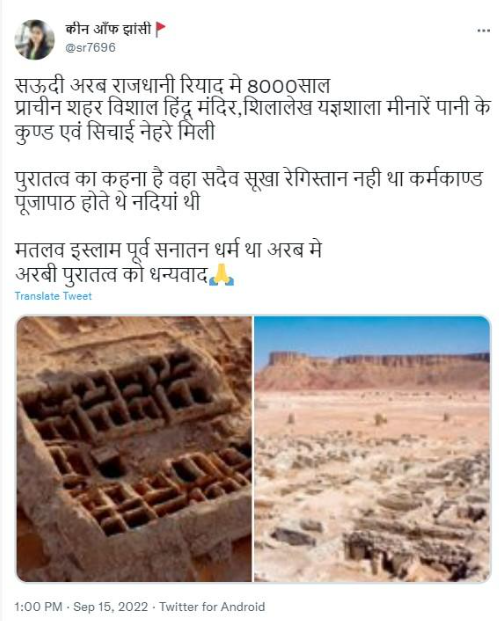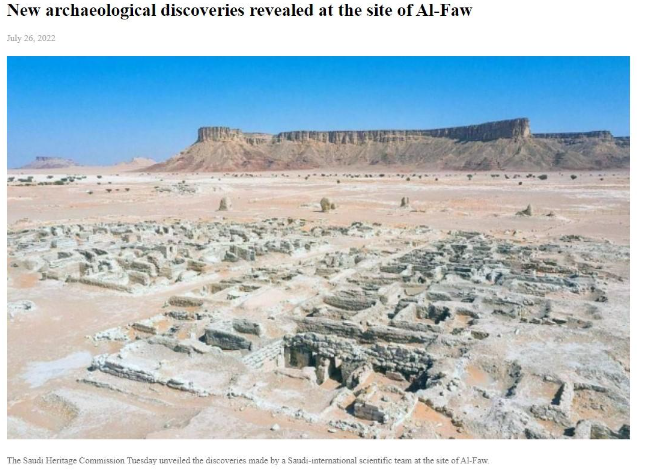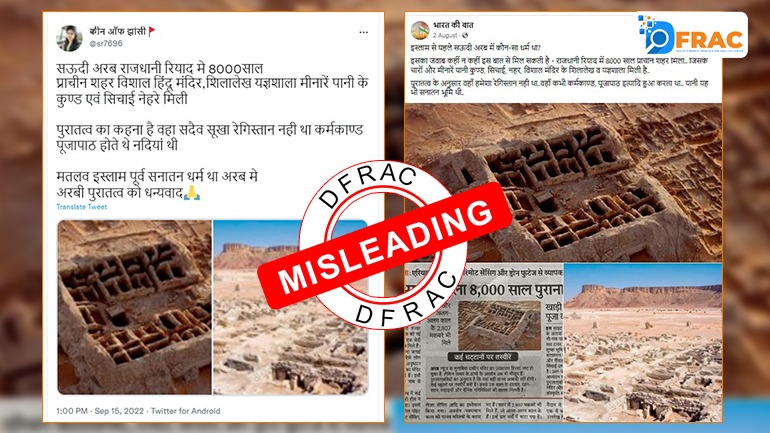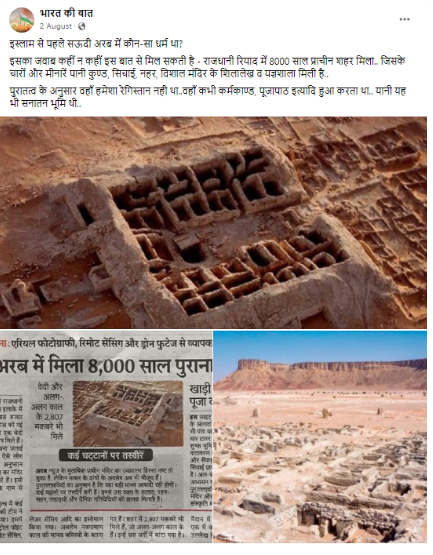A claim along with some pictures of an archaeological excavation site is going viral on social media platforms. Sharing the picture, a Twitter user क्वीन आँफ झांसी wrote, “8000 years in Saudi Arabia’s capital Riyadh Ancient city, huge Hindu temple, inscriptions, Yagya shala minarets, water pools, and irrigation eyes were found Archaeology says that there was not always a dry desert, there was ritualistic worship, there were rivers. Meaning Islam was pre-Sanatan religion in Arabia Thanks to Arabic Archeology.” {English Translation}

Soon this post got viral with a hundredth of likes and retweets.
In the same vein, a Facebook user shared these pictures with a newspaper of Patrika captioned the picture, “What was the religion in Saudi Arabia before Islam? The answer can be found somewhere from this thing – 8000 years old city was found in the capital Riyadh.. around which towers, water tanks, irrigation, canal, huge temple inscriptions, and Yagya shala have been found. According to archaeology, there was not always a desert. There used to be rituals, worship, etc. That is, it was also an eternal land.” {English Translation}
Similarly, many other social media users have shared these pictures with the same claim.
Fact Check
Probing the viral claim the DFRAC team found a report by saudigazette.com about the New archaeological discoveries revealed at the site of Al-Faw.

Key findings of this excavation in Saudi Arabia
· Devotional inscriptions. One of these structures is the Jabal Lahaq sanctuary that is addressed to the god Kahal, the deity of Al-Faw, by a person named W H B L T (Wahb Allat) from the family of M L H T (Malha), locals of Guerra (the city of Al-Jarha).
· Foundations of four massive buildings with their corner towers, that could potentially have functioned as resting places for weary travelers and their caravans.
· Complex irrigation system, including canals, water cisterns, and hundreds of pits, dug by the residents of Al-Faw to bring rainwater to the agricultural areas
· The potential presence of widespread agricultural fields that grew a variety of crops.
· A series of rock art and other inscriptions on Mount Tuwaiq, known as Khashem Qaryah, east of Al-Faw.
· 2,807 graves from different time periods dotted throughout the site.
Further, it is also mentioned that the inscription indicates a relationship between the cities of Al-Faw and Al-Jarh. — most likely commercial considering Al-Faw’s location on the ancient trade route. That may also imply either religious tolerance between residents of the two cities or the worship of Al-Faw’s deity, Kahal, by some of the residents of Al-Jarha.
Moreover, according to UNESCO, “ Al-Faw hosted various types of human occupation throughout history: from prehistoric nomadic and semi-nomadic presence to an urban settlement when a thriving ancient caravan city developed in the second half of the 1st millennium BCE.”
This is not the first time this claim got viral, DFRAC team have found many post of August with similar claims.
Conclusion
The devotional inscriptions and the temples found in the excavation are related to Al- Faw’s deity. Hence, the claims of users that a Hindu temple was found in Saudi Arabia or Hinduism was prevailing in Saudi Arabia before Islam holds no basis.






